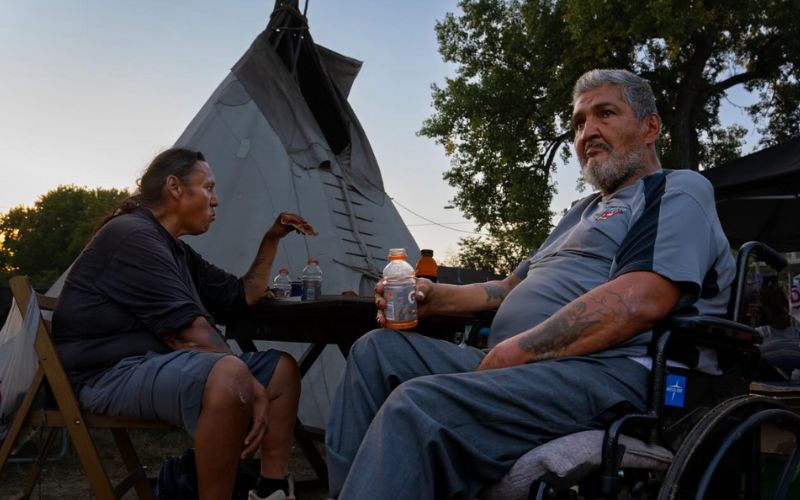
- Details
- By Kaili Berg
Nearly 150 people were evicted earlier this month from Camp Nenookaasi, a community-based healing camp in Minneapolis rooted in Native practices where people experiencing homelessness can find stable interim shelter.
The camp has occupied a vacant city lot in the East Phillips neighborhood of Minneapolis since August 2023, but residents began folding tents and gathering belongings after Mayor Jacob Frey scheduled the eviction and destruction of the camp on January 4.
Plans to close the camp in December were postponed. On January 2, residents of Camp Nenookaasi filed a lawsuit against Frey in an attempt to halt the eviction process, but a federal judge denied their request, allowing the city to move forward.
Insulated tents, yurts, teepees, and other shelters have been removed, as well as the camp's ceremonial fire and other sacred sites. Residents were left to face the deadly Minnesota winter weather, where temperatures have reached negative levels this past week, according to the Weather Channel.
Camp Nenookaasi (Hummingbird) has served as a crucial stepping stone to housing stability and sobriety while providing food, warmth, shelter, and cultural healing for its residents, who are mainly Indigenous. Since its inception, nearly 76 residents have been able to obtain long-term or permanent housing.
“The camp is a creation of social safety and a real meaningful community,” Camp Nenookaasi organizer Christina Crabtree, told Native News Online. “That sense of safety is what lays down the foundation for people to start to heal traumas and start seeing that they are worthy of care, housing, recovery, and healing. We have stayed together.”
American Indian/Alaska Natives experience the second highest rate of homelessness in the U.S., according to the latest Annual Homelessness Assessment Report by the National Alliance to End Homelessness. As of 2019, AI/AN people account for approximately 1.5% of North America’s population, yet they make up more than 10% of the homeless population nationally, according to the HUD report.
Nearly 80% of Native people no longer live on reservations, and little funding is directed specifically toward them. Tribal governments usually allocate the funds they do get for life on the reservation, as required by the federal government.
City officials said a number of services will be offered to displaced residents of Camp Nenookaasi, including storage, shelter, mental health resources, and health care as an incentive to leave. Residents who hadn’t gotten the help they were promised simply moved to a new encampment a few blocks away according to FOX9.
Frey campaigned for mayoral office on a promise to end homelessness before being sworn into office on January 2, 2018. Frey was involved in efforts to create and fund a navigation center, and has worked with non-profit partners and the Red Lake Nation to house and shelter residents according to the city.
Back in 2018, the Wall of Forgotten Natives, a homeless encampment along the highway sound barrier that separates Hiawatha Avenue from East Phillips, was shut down. According to the city, Frey created a partnership with Red Lake to provide encampment residents with culturally specific housing and other services.
In 2020, Powderhorn Park encampment was formed due to the increasing need for access to treatment and housing services, but it was soon shut down due to an increase in violence and safety concerns.
Crabtree says that clearing Camp Nenookaasi will scatter unhoused people throughout the city, making it more difficult for them to meet with housing workers and receive community resources. She also notes that unhoused people are more likely to experience violence.
“There have been so many encampment evictions week after week. There are people who don’t have these residents' best interests in mind,” Crabtree said. “People are predatory who know where the camps are and when an eviction happens and residents are in that place of hopelessness, they can easily be taken advantage of. We see people even go missing after encampment evictions.”
The city says they will continue to work with Red Lake Nation toward a healing center and with the Indigenous Peoples Task Force to construct the Mikwanendun Audisookon Art and Wellness Center. Plans to complete the purchase will be in February and pre-development activity will start on the site soon.
“There are so many different ideas about solutions, but the majority of the time these organizations that want to help are so underfunded and competing for the same resources. We need to all realize that people are suffering and as long as we stay divided, we are going to stay stuck in this cycle,” Crabtree said.
Correction: This article has been updated to reflect Mayor Frey's office's involvement in working with the Red Lake Nation and area non-profits to transition displaced residents from the Wall of Forgotten Natives encampment.
More Stories Like This
Native News Weekly (August 25, 2024): D.C. BriefsUS Presidents in Their Own Words Concerning American Indians
Navajo Man Faces Vehicular Homicide Charge After Child Killed at Navajo Nation Christmas Parade
Suspected Drunk Driver Crashes into Parade in Kayenta on Navajo Nation, Killing 1 & Injuring 3 Others
Tribal Broadband to Get $6.5M Boost as NTIA Plans Consultations
Help us defend tribal sovereignty.
At Native News Online, our mission is rooted in telling the stories that strengthen sovereignty and uplift Indigenous voices — not just at year’s end, but every single day.
Because of your generosity last year, we were able to keep our reporters on the ground in tribal communities, at national gatherings and in the halls of Congress — covering the issues that matter most to Indian Country: sovereignty, culture, education, health and economic opportunity.
That support sustained us through a tough year in 2025. Now, as we look to the year ahead, we need your help right now to ensure warrior journalism remains strong — reporting that defends tribal sovereignty, amplifies Native truth, and holds power accountable.
 The stakes couldn't be higher. Your support keeps Native voices heard, Native stories told and Native sovereignty defended.
The stakes couldn't be higher. Your support keeps Native voices heard, Native stories told and Native sovereignty defended.
Stand with Warrior Journalism today.
Levi Rickert (Potawatomi), Editor & Publisher

